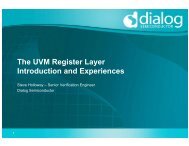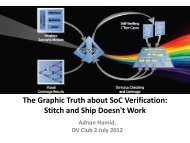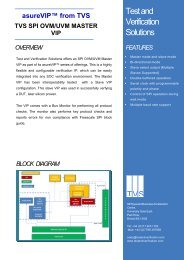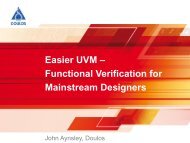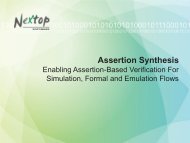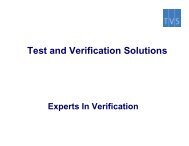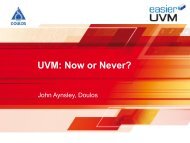NXP Semiconductors - Test and Verification Solutions
NXP Semiconductors - Test and Verification Solutions
NXP Semiconductors - Test and Verification Solutions
Create successful ePaper yourself
Turn your PDF publications into a flip-book with our unique Google optimized e-Paper software.
Scalable <strong>Verification</strong> Framework<br />
Aniruddha Baljekar<br />
<strong>NXP</strong> <strong>Semiconductors</strong><br />
19 th March 2013
Overview<br />
Motivation/Rationale<br />
Solution Insight<br />
– Module Level <strong>Verification</strong><br />
– Sub-system Level <strong>Verification</strong><br />
– System Level <strong>Verification</strong><br />
Results<br />
Conclusions<br />
Next Steps<br />
Questions<br />
2
Motivation/Rationale<br />
Extensive Pre-silicon <strong>Verification</strong> <strong>and</strong> Improved Design Flow<br />
Platform based verification environment<br />
IC <strong>Verification</strong><br />
– How to enable support to scalable platforms for SoC verification<br />
• Ease of extensibility, configurable topology, processor independent env.<br />
• Configurable/Adaptive methodology for SoC verification<br />
– How to enable re-use infrastructure from Module Level to System Level<br />
<strong>Verification</strong><br />
– Common Industry St<strong>and</strong>ard <strong>Verification</strong> Methodology from Module Level<br />
verification to Subsystem/System level verification<br />
3
Motivation/Rationale<br />
HW/FW/MW co-verification<br />
– How enable re-usability of <strong>Test</strong> Cases/SW from Pre-silicon to Post Silicon<br />
Validation?<br />
– How to share simulation snapshot to SW team?<br />
– How to enable test-case writing at System level test-case without knowing<br />
the HVL Language e.g. Software Engineer?<br />
– How to control execution <strong>and</strong> constraining software <strong>and</strong> Hardware Stimuli?<br />
– How to get functional coverage details of HW/SW API's/<strong>Test</strong>s?<br />
– How to Ease Debugging HW/SW for failures?<br />
4
Solution Insight<br />
Module Level <strong>Verification</strong><br />
Virtual Sequencer<br />
vIP’s for various interfaces implemented<br />
by the DUT<br />
Scoreboard for data integrity checks <strong>and</strong><br />
checkers for protocol compliance<br />
eManager for automation/vPlan for<br />
defining coverage goals<br />
Re-use of vIP’s (OVC’s) across<br />
projects/DUT’s<br />
Supports interoperability between different<br />
languages<br />
Open <strong>Verification</strong> Methodology Industry<br />
st<strong>and</strong>ard methodology to achieve metricsdriven<br />
verification (MDV)<br />
5
Solution Insight<br />
Sub-System Level <strong>Verification</strong><br />
Sub-System Level <strong>Verification</strong> Environment<br />
6
Solution Insight<br />
Sub-System Level <strong>Verification</strong><br />
<strong>Verification</strong> environment uses :<br />
– Metrics driven verification methodology using OVM.<br />
– Incisive Software Extensions package to control/constrain execution of<br />
Software<br />
– vIP’s to control/constrain HW stimuli<br />
– Re-use of module level vIP’s (e.g AHB, APB, SWD etc) for protocol<br />
compliance checks<br />
– Scoreboard to check data integrity<br />
– Coverage details to get insight into the progress of the verification goals<br />
– Virtual sequences to co-ordinate/control test scenarios to be executed on<br />
CPU <strong>and</strong> vIP’s on different interfaces<br />
– eManager to support automatic regression runs<br />
– vPlan to capture the code coverage <strong>and</strong> functional coverage goals<br />
7
Solution Insight<br />
Sub-System Level <strong>Verification</strong><br />
Functional Checks :<br />
– Interconnection<br />
– Sub-module functionality<br />
– Interrupt h<strong>and</strong>ling<br />
– Debug interface<br />
– Features of CPU<br />
– Clock gating features implemented in the subsystem<br />
– Dynamic traffic on multiple interfaces of the DUT<br />
Automation of regression runs using Enterprise Manager<br />
Coverage goals mapped to vPlan for final sign-off<br />
8
Solution Insight<br />
System Level/Pre-Silicon <strong>Verification</strong><br />
System Level /Pre-Silicon <strong>Verification</strong> Environment<br />
9
Solution Insight<br />
System Level/Pre-Silicon <strong>Verification</strong><br />
Scalable <strong>Verification</strong> framework<br />
– Extensible, Processor Independent, configurable Topology<br />
<strong>Test</strong> Stimulus generated using TCL (No recompilation of ENV)<br />
TCL scripts provide hooks to the Sequencer of vIP’s<br />
Re-use of the verification environment from Subsystem Level<br />
Convergence of <strong>Verification</strong> setup <strong>and</strong> Validation setup<br />
– Stimulus generated for Pre-Silicon verification re-produceable for Post-<br />
Silicon Validation<br />
10
Results<br />
Scalable System Level <strong>Verification</strong> Environment<br />
– Ease of extensibility<br />
– Processor Independent<br />
– Configurable Environment (enable/disabling of verification components)<br />
Environment enables r<strong>and</strong>omization of SW <strong>and</strong> HW stimuli<br />
– Methodology enables HAL API’s verification when SW application is not<br />
available<br />
Bottom-up verification approach<br />
– Module Level <strong>Verification</strong> (for new IP’s Developed)<br />
– Reuse the vIP’s <strong>and</strong> key verification components at System Level<br />
Reduced Bug propagation to System Level => Reduced Debug effort<br />
Re-use of infrastructure IP’s across verification scope<br />
11
Conclusions<br />
Platform Centric <strong>Verification</strong> Approach<br />
– Addresses the key project requirements<br />
Environment is easily Scalable<br />
Innovative approach to enable generation of constrain r<strong>and</strong>omization of<br />
SW <strong>and</strong> HW stimuli<br />
– Enables testing of SW API (When application SW not available)<br />
OVM based Metrics Driven <strong>Verification</strong> Methodology is suitable @<br />
– Module Level <strong>Verification</strong><br />
– Subsystem Level <strong>Verification</strong><br />
– System Level <strong>Verification</strong><br />
No bugs propagated from Module Level (verified with MDV) to System<br />
Level<br />
vIP’s reusable across organisation<br />
Single Framework @ System Level <strong>Verification</strong> (Reduced Maintainability)<br />
12
Conclusions (contd. …)<br />
Reduced Silicon bring-up effort (for first received samples)<br />
Convergence of <strong>Verification</strong> <strong>and</strong> Validation setup (Reuse SW <strong>and</strong> Stimuli)<br />
– Reduced development effort<br />
vIP’s available for Re-use to the Next Projects/across projects<br />
13
Next Steps<br />
Migration to UVM<br />
Use complementary methodology/solution e.g IFV<br />
Re-use of module level test cases @ System Level<br />
Mixed Mode simulations with digital infrastructure?<br />
14
Questions<br />
15
Thank you





